- Marguerite Louise d'Orléans
-
Marguerite Louise d'Orléans 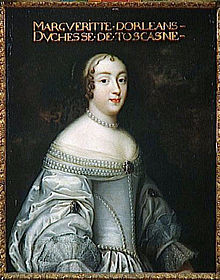
Grand Duchess of Tuscany Consort 23 May 1670 - 17 September 1721 Spouse Cosimo III de' Medici, Grand Duke of Tuscany Issue Ferdinando, Grand Prince of Tuscany
Anna Maria Luisa, Electress Palatine
Gian Gastone, Grand Duke of TuscanyFull name Marguerite Louise d'Orléans House House of Bourbon
House of MediciFather Gaston of France Mother Marguerite of Lorraine Born 28 July 1645
Château de Blois, Blois, FranceDied 17 September 1721 (aged 76)
15 Place des Vosges, Paris, FranceBurial Picpus Cemetery, Paris, France Marguerite Louise d'Orléans (28 July 1645 – 17 September 1721) was Grand Duchess of Tuscany, as the wife of Grand Duke Cosimo III de' Medici. Deprived of her lover, Charles V of Lorraine, and yearning for France, Marguerite Louise despised her husband and his family, whom she often quarrelled with and falsely suspected of attempting to poison her. Marguerite Louise reconciled with the Medici on more than one occasion, however, only to promptly resume hostilities.
Having become Grand Duke of Tuscany upon his father's death, in 1670, Cosimo III, under the sway of his mother, Vittoria della Rovere, refused to grant Marguerite Louise entry to the Consulta (Privy Council). Thus without political influence, Marguerite Louise oversaw the education of her eldest son, Grand Prince Ferdinando. Two more children followed: Anna Maria Luisa, Electress Palatine, and Gian Gastone, the last Medici Grand Duke of Tuscany.
In June 1675, having signed a contract with Cosimo III the previous December stipulating an 80,000 livres pension, Marguerite Louise was allowed to return to France, on the condition she reside in the Abbaye Saint Pierre de Montmartre, near Paris. A daughter of Gaston de France, Duke of Orléans, Marguerite Louise was obliged to surrender her rights as Princess of France in Cosimo's contract. Although the contract, too, banned her from leaving the convent, Marguerite Louise often went to her cousin Louis XIV's court at Versailles, where she gambled for high stakes. She was at the centre of many scandals at the convent, including an attempt to burn it down, which greatly irritated her husband, who, despite the separation, took great interest in Marguerite Louise's life. While still technically married, Marguerite Louise had several affairs
Contents
Biography
Early life: 1645-1661
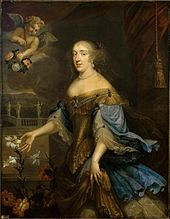 Marguerite Louise's favourite sister the Duchess of Montpensier and the wealthiest heiress in France, after the school of Pierre Mignard
Marguerite Louise's favourite sister the Duchess of Montpensier and the wealthiest heiress in France, after the school of Pierre Mignard
Marguerite Louise, the eldest child of Gaston of France, Duke of Orléans, and of his second wife, Marguerite of Lorraine, was born on 18 July 1645.[1] Born at the Château de Blois, she was the oldest of five children born to Gaston by his second wife. Her other sisters included Élisabeth Marguerite, future Duchess of Guise and the Duchess of Savoy.
Marguerite Louise received a rudimentary education at her father's court at Blois, where he retreated to after his failed insurrection against his nephew Louis XIV of France, the Fronde.[1] Marguerite Louise enjoyed a close relationship with her half-sister, Anne Marie Louise, Duchess of Montpensier, La Grande Mademoiselle, who took her and her friends to the theatre and royal balls; Marguerite Louise reciprocated her sister's affection, attending daily Anne Marie Louise's salon and seeking her guidance in court matters.[2] Madame de Choisy, Marguerite Louise believed, poorly advised her mother in matters of court and ruined her marriage negotiations with Charles Emmanuel II, Duke of Savoy.[3] Therefore, when another proposal came, this time from Cosimo de' Medici, Grand Prince of Tuscany, in 1658, Marguerite Louise asked her half-sister to ensure its fulfilment.[4] Her own younger sister Françoise Madeleine d'Orléans married Charles Emmanuel II in 1663.
Initially overjoyed at the prospect of marrying, Marguerite Louise's ebullience faded to dismay when she discovered her half-sister no longer favoured the Tuscan match, as she did before.[4] After this rebut, Marguerite Louise's behaviour became erratic: she shocked the court by going out unaccompanied, a grievous offence in contemporary French society, with her cousin Prince Charles of Lorraine, who soon became her lover.[5] Her marriage by proxy, on 19 April 1661, did nothing to change her attitude, much to Louis XIV's ministers' discontentment; on the day she was supposed to meet diplomats offering their congratulations on the wedding, she attempted to abscond and go hunting, only to be stopped by the Duchess of Montpensier.[6]
Life in Tuscany: 1661-1670
Grand Princess of Tuscany
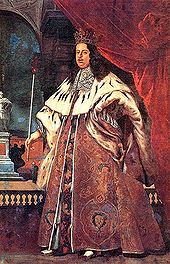 Cosimo III de' Medici, Marguerite Louise's husband, whom she hated, in Grand Ducal regalia
Cosimo III de' Medici, Marguerite Louise's husband, whom she hated, in Grand Ducal regalia
Mattias de' Medici, the incumbent Grand Duke's brother, brought Marguerite Louise to Tuscany in a fleet comprising nine galleys, three Tuscan, three on loan from the Republic of Genoa and another three from the Papal States. She arrived in Tuscany on 12 June, disembarking at Livorno, and, to much pageantry, made her formal entry to Florence on 20 June.[7] Their wedding, the most lavish spectacle Florence had hitherto seen, was composed of a retinue of over three-hundred carriages.[8] As a wedding gift, Grand Duke Ferdinando, the bridegroom's father, presented her with a pearl the "size of a small pigeon's egg".[8]
Marguerite Louise and Cosimo greeted each other with indifference, and, according to Sophia, Electress of Hanover, they only slept together once a week.[9] Marguerite Louise, two days after their marriage, demanded possession of the Tuscan crown jewels from Cosimo, who replied that he did not have the authority to give them.[10] The jewels that she did manage to get from Cosimo she tried to smuggle out of Tuscany, only to be stopped by the Grand Duke.[10] Marguerite Louise's indifference, after this incident, turned to hatred, compounded by her love for Charles of Lorraine, from whom she was forced to part at Marseilles.[11] On one occasion, she threatened to break a bottle over Cosimo's head if he did not leave her chamber.[8] Her hatred of Cosimo, however, did not get in the way of children: Grand Prince Ferdinando in 1663, Anna Maria Luisa in 1667 and Gian Gastone in 1671. Cosimo's family, too, were the victims of Marguerite Louise's caprices: she argued with the Grand Duchess Vittoria over precedence, Grand Duke Ferdinando over her profligacy.[12] Marguerite Louise's spending habits not only made her unpopular with the Grand Duke, but with the Florentines, who were tired of her lax etiquette, two grooms frequented her chamber at all hours.[12]
Entreaties to Louis XIV
Following Charles of Lorraine's brief visit to Florence, during which he was entertained by the Grand Ducal family in Palazzo Pitti, the Grand Ducal palace, the tone of Marguerite Louise's letters to Charles compelled the Grand Duke and Cosimo to spy on her.[13] In response, she begged Louis XIV to intervene, but he stealthily declined.[13] Both Marguerite Louise and the Grand Duke sent entreaties to Louis XIV following the dismissal of Marguerite Louise's French staff, the former complaining of her maltreatment, the latter asking for Marguerite Louise's behaviour to be curbed.[14]
To placate both the Grand Duke and Marguerite Louise, he sent the comte de Saint Mêmê. Marguerite Louise wanted to return to France, and Mêmê sympathised with this, as did much of the French court, so he left without finding a solution to the heir's domestic disharmony, incensing both Ferdinando and Louis XIV.[15][16][17] Now, she humiliated Cosimo at every chance she got: she insisted on employing French cooks only as she feared the Medici were out to poison her and branded Cosimo "a poor groom" in front of the Papal nuncio.[16]
After several more attempts at French conciliation failed, in September 1664 Marguerite Louise left her apartment in Palazzo Pitti, refusing to return; therefore, Cosimo moved her into Villa di Lappeggi.[16] where she was watched by forty soldiers, and six courtiers, appointed by Cosimo, had to follow her everywhere because it was feared she would abscond.[18] The next year, she changed tack, and reconciled with the Grand Ducal family. The delicate rapprochement that existed between Marguerite Louise and the rest of the family collapsed after Anna Maria Luisa's birth, in 1667, when she caught smallpox.[19]
Grand Duchess of Tuscany: 1670-1721
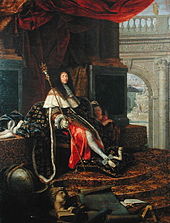 Louis XIV of France, Marguerite Louise's first cousin, from a painting by Henri Testelin
Louis XIV of France, Marguerite Louise's first cousin, from a painting by Henri Testelin
In May 1670, with the death of Grand Duke Ferdinando II, Marguerite Louise became Grand Duchess of Tuscany. The old tradition of admitting the Grand Duke's mother to the Consulta, or Privy Council, was reinstituted at Cosimo III's accession.[20] Loathing Marguerite Louise for her treatment of Cosimo and herself, Vittoria della Rovere, Cosimo III's mother, ensured that Marguerite Louise was excluded from politics, leaving her with nought else to do but supervise her son the Grand Prince Ferdinando's education.[21][22] The Grand Duchess, furious at her exclusion, fought with Vittoria over precedence and demanded entry to the Consulta.[22] Cosimo III sided with his mother.[22] By early 1671, fighting between Marguerite Louise and Vittoria became so heated that a contemporary remarked that "the Pitti Palace has become the devil's own abode, and from morn till midnight only the noise of wrangling and abuse could be heard".[23]
Return to France
At the start of 1672, Marguerite Louise wrote to Louis XIV, begging him for medical assistance as she believed she had breast cancer.[24] Louis XIV sent Alliot le Vieux, Anne of Austria's personal physician, to tend to her.[23] Alliot, unlike Mêmê, did not completely comply with Marguerite Louise's plot to be sent to France, under the guise of illness, pronouncing that the tumour was "nonwise malignant", though he did recommend thermal waters.[23][25] Frustrated with the failure of her plan, Marguerite Louise began flirting with a cook in her household, tickling him and having pillow fights, to upset Cosimo.[26]
To restore domestic harmony, Cosimo III sent for Madame du Deffand, Marguerite Louise's childhood governess who had tried, but failed, to help the Grand Duke before.[22] However, because of a string of deaths in the Orléans family, she arrived late, in December 1672.[27] By then, Marguerite Louise was in the depths of despair, and asked to be allowed visit Poggio a Caiano, a Medici villa, ostensibly for worship at a nearby shrine.[28] Once there, she refused to return, which resulted in a two-year stand off between herself and the Grand Duke, for he would not consent to her return to France, a return she begged for in her parting letter to him.[29] Madame du Deffand's mission having failed, Louis XIV made one final attempt to reconcile the Grand Ducal couple, to no avail.[30] Therefore, all attempts at conciliation having failed, Cosimo capitulated to Marguerite Louise, in a contract signed on 26 December 1674: Marguerite Louise, provided for with a pension of 80,000 livres, was allowed to leave for France, but she had to confine herself to the Saint Pierre Abbey of Montmartre and surrender her rights as a Royal Princess of France.[31] Overjoyed, the Grand Duchess departed for France laden down with the fixtures and furniture of Poggio a Caino, for, in her own words, she had no intention "of setting forth without her proper wages".[32]
Montmartre
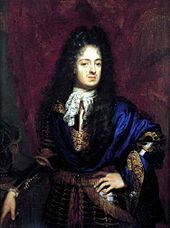 The Grand Prince Ferdinando, Marguerite Louise's eldest son, by Niccolò Cassana, 1687
The Grand Prince Ferdinando, Marguerite Louise's eldest son, by Niccolò Cassana, 1687
News of Marguerite Louse's departure from Livorno on the 12 July 1675 was greeted with "a great displeasure" by the Florentines.[33] The nobility, too, sympathised with her, falsely believing Cosimo was to blame for driving Marguerite Louise from Tuscany.[33] Marguerite Louise, initially, patronised charitable works at Montmartre and bore herself with "an air of piety", but soon reverted to her profligate ways, wearing heavy rouge and bright yellow periwigs, and embarking on an affair with the Count of Lovigny, and later with two members of the Luxembourg regiment.[34][35] Louis XIV, ignoring the 1674 contract's article banning Marguerite Louise from stepping foot outside the convent, allowed the Grand Duchess to court, where she gambled for high stakes.[36]
Because of her "shabby" retinue and short visits, Marguerite Louise garnered the reputation of a Bohemian among the courtiers of Versailles, and, therefore, was compelled to allow "those of insignificant birth" into her circle.[35] The Tuscan envoy, Gondi, issued frequent protests to the French court of Marguerite Louise's behaviour, to no avail.[37] Eventually, the Abbess of Montmartre, Françoise Renée de Lorraine, (1621–1682), when quizzed by the King about Marguerite Louise's latest affair with a groom, interceded, saying, "A conspiracy of silence is the sole antidote to the depravity and excesses of [Marguerite Louise]"; this explains Marguerite Louise's absence from memoirs of the time.[37]
Back in Florence, Cosimo III had the Tuscan envoy report on Marguerite Louise's every movement, which he closely scrutinised. If he deemed a particular action of hers to be offensive, he wrote to Louis XIV, demanding an explanation.[38] Initially sympathetic with Cosimo, Louis XIV, tiring of his endless stream of protests, said, "Since Cosimo had consented to the retirement of his wife to France, he had virtually relinquished all right to interfere in her conduct".[39] That Cosimo III ceased meddling in the affairs of his wife was the result of Louis XIV's rebut.[40] Marguerite Louise was informed of Cosimo III's ensuing illness by her eldest son, Grand Prince Ferdinando, who espoused his mother's cause and corresponded with her.[40][41] Marguerite Louise, confident of her husband's imminent death, told the French court that "at the first notice of her detested husband's demise, she would fly to Florence to banish all hypocrites and hypocrisy and establish a new government".[40] This, however, was not to be, and Cosimo III actually outlived her two years.
In 1688, saturated in debt, Marguerite Louise wrote to Cosimo, begging for 20,000 crowns. When Cosimo was not initially forthcoming, she switched her focus to her son the Grand Prince, in the hope he would help her, but he feigned he could not, for fear of upsetting his father.[42] Eventually, Cosimo paid off her debts, and her financial security was assured when she inherited a large sum of money from a relative in 1696.[43][44]
While Marguerite Louise's behaviour—at its worst when she threatened to burn down the convent—was tolerated by the previous Abbess of Montmartre, the new Abbess, Madame d'Harcourt, frequently complained of her to the Grand Duke and the King.[44] In retaliation, Marguerite Louise threatened to kill her with a hatchet and a pistol, and formed a clique against her.[45] Therefore, in line with her wishes, Cosimo III consented to Marguerite Louise's departure for a new convent, Saint-Mandé, on the condition she only leave with the King Louis XIV's explicit permission and be attended to by a chamberlain of his choice.[46] Since she would not assent to these prerequisites, the payment of her pension was suspended, only to be resumed when Louis XIV compelled her to yield.[46]
Saint-Mandé
At Saint-Mandé, Marguerite Louise underwent a transformation: she no longer cared for "excesses", and busied herself with reforming the convent, which she called a "spiritual brothel"; the absentee mother superior, who wore men's clothing, was sent away, non-conformist nuns were removed and it is because of these deeds her behaviour no longer proved a bone of contention with Florence.[46] Marguerite Louise's health began to decline in 1712, with an attack of apoplexy, which left her with a paralysed left arm and foaming mouth.[47] She soon recovered, only to suffer another attack the next year; the death of the only one of her three children she cared for, Grand Prince Ferdinando, contributed to the second attack of apoplexy, which briefly paralysed her eyes and made speech difficult.[47] The Regent of France, Philippe d'Orléans, allowed Marguerite Louise to buy a house in Paris, 15 Place des Vosges, where she spent her final years.[47] She corresponded with the Regent's mother, Elizabeth Charlotte of the Palatinate, and gave assiduously to charity.[47] Marguerite Louise d'Orléans, Princess of France and Grand Duchess of Tuscany, died in September 1721, and was buried in Picpus Cemetery, in Paris.[48]
Issue
Cosimo III and Marguerite Louise had three children:
- Ferdinando de' Medici, Grand Prince of Tuscany (b.1663 d.1713) married Violante Beatrice of Bavaria, no issue;
- Anna Maria Luisa de' Medici, Electress Palatine (b.1667 d.1743) married Johann Wilhelm, Elector Palatine, no issue;
- Gian Gastone de' Medici, Grand Duke of Tuscany (b.1671 d.1737) married Anna Maria Franziska of Saxe-Lauenburg, no issue.
Ancestors
Ancestors of Marguerite Louise d'Orléans 16. Charles de Bourbon, Duke of Vendôme 8. Antoine de Bourbon, Duke of Vendôme 17. Françoise d'Alençon 4. Henry IV of France 18. Henry II of Navarre 9. Jeanne III of Navarre 19. Marguerite of Navarre 2. Gaston of France, Duke of Orléans 20. Cosimo I de' Medici, Grand Duke of Tuscany 10. Francesco I de' Medici, Grand Duke of Tuscany 21. Eleonora di Toledo 5. Marie de' Medici 22. Ferdinand I, Holy Roman Emperor 11. Johanna of Austria 23. Anne of Bohemia and Hungary 1. Marguerite Louise d'Orléans 24. Francis I, Duke of Lorraine 12. Charles III, Duke of Lorraine 25. Princess Christina of Denmark 6. Francis II, Duke of Lorraine 26. Henry II of France 13. Claude of France 27. Catherine de' Medici 3. Marguerite of Lorraine 28. Johann VII, Count of Salm 14. Paul, Count of Salm 29. Claude de Stainville 7. Christina of Salm 30. Tanneguy Le Veneur, Count of Tillières 15. Marie Le Veneur 31. Madeleine Hélie de Pompadour Titles, styles, honours and arms
Titles and styles
- 28 July 1645 – 12 June 1661 Her Royal Highness Mademoiselle d'Orléans
- 12 June 1661 – 23 May 1670 Her Royal Highness the Grand Princess of Tuscany
- 23 May 1670 – 17 September 1721 Her Royal Highness the Grand Duchess of Tuscany
References
Citations
- ^ a b Acton, p. 54.
- ^ Pitts, p. 159.
- ^ Pitts, pp. 159-160.
- ^ a b Pitts, p. 160.
- ^ Pitts, p. 161.
- ^ Pitts, p. 162.
- ^ Acton, p. 70.
- ^ a b c Strathern, p. 386.
- ^ Hibbert, p 288.
- ^ a b Hibbert, p. 289.
- ^ Acton, p 85
- ^ a b Acton, p. 86.
- ^ a b Acton, p 87.
- ^ Acton, pp, 88-89.
- ^ Acton, pp. 91-92.
- ^ a b c Acton, p 93.
- ^ Young, p 453.
- ^ Acton, p 94.
- ^ Acton, p 103.
- ^ Acton, p. 113.
- ^ Young, p 460.
- ^ a b c d Acton, p. 114.
- ^ a b c Acton, p. 115.
- ^ Hibbert, p. 293.
- ^ Hibbert, pp. 293-294.
- ^ Hibbert, p. 294.
- ^ Acton, p. 119.
- ^ Acton, p. 120.
- ^ Young, pp. 460-461.
- ^ Hibbert, p. 295.
- ^ Acton, p. 135.
- ^ Acton, p. 136.
- ^ a b Acton, p. 138.
- ^ Hibbert, p. 296.
- ^ a b Acton, p. 145.
- ^ Acton, pp. 144-145.
- ^ a b Acton, p 148.
- ^ Acton, p. 152.
- ^ Acton, pp. 154-155.
- ^ a b c Acton, p. 155.
- ^ Young, p. 464.
- ^ Acton , p. 278.
- ^ Acton, p. 279.
- ^ a b Strathern, p. 389.
- ^ Acton, p; 195.
- ^ a b c Acton, p. 196.
- ^ a b c d Acton, p 273.
- ^ Acton, p. 274.
Bibliography
- Acton, Harold (1980). The Last Medici. Macmillan. ISBN 0-333-29315-0
- Hibbert, Christopher (1979). The Rise and Fall of the House of Medici. Penguin. ISBN 978-0-14-005090-5.
- Pitts, Vincent Joseph (2000). La Grande Mademoiselle at the Court of France. The Johns Hopkins University Press. ISBN 0-8018-6466-6.
- Strathern, Paul (2003). The Medici: Godfathers of the Renaissance. Vintage. ISBN 978-0-099-52297-0.
- Young, G.F. (1920). The Medici: Volume II. John Murray.
External links
 Media related to Marguerite Louise d'Orléans at Wikimedia Commons
Media related to Marguerite Louise d'Orléans at Wikimedia CommonsSee also
Marguerite Louise d'OrléansBorn: 28 July 1645 Died: 17 September 1721Italian royalty Preceded by
Vittoria della RovereGrand Ducal consort of Tuscany
23 May 1670 - 17 September 1721Succeeded by
Anna Maria Franziska of Saxe-LauenburgPrincesses of Orléans The first generation are the children of Gaston, Duke of Orléans, son of Henry IV; the second is from Philippe, Duke of Orléans, son of Louis XIII;1st Generation Anne Marie Louise, Duchess of Montpensier^ · Marguerite Louise, Grand Duchess of Tuscany^ · Élisabeth Marguerite, Duchess of Guise^ · Françoise Madeleine, Duchess of Savoy^ · Princess Marie Anne^
2nd Generation Marie Louise, Queen of Spain^ · Anne Marie, Queen of Sardinia^ · Élisabeth Charlotte, Duchess of Lorraine^
3rd Generation Louise Élisabeth, Duchess of Berry^ · Louise Adélaïde, Abbess of Chelles^ · Charlotte Aglaé, Duchess of Modena^ · Louise Élisabeth, Queen of Spain^ · Philippine Élisabeth, Mademoiselle de Beaujolais^ · Louise Diane, Princess of Conti^
4th Generation Princess Louise Marie^
5th Generation Mademoiselle d'Orléans^ · Bathilde, Princess of Condé^
6th Generation Françoise, Mademoiselle de Chartres^ · Adélaïde, Princess of Orléans
7th Generation Louise, Queen of the Belgians · Marie, Duchess of Württemberg · Princess Françoise · Clémentine, Princess of Kohary
8th Generation Marguerite Adelaide, Princess Czartoryska · Princess Blanche · Françoise, Duchess of Chartres · Marie Isabelle, Countess of Paris · Princess Amalia · Princess Cristina · Princess Maria de la Regla · Mercedes, Queen of Spain
9th Generation Amélie, Queen of Portugal · Hélène, Duchess of Aosta · Isabelle, Duchess of Guise · Louise, Princess Carlos of the Two Sicilies · Marie, Princess Valdemar of Denmark · Margherite, Duchess of Magenta · Louise, Princess Alfons of Bavaria
10th Generation Isabelle, Princess Pierre Murat · Françoise, Princess Cristopher of Greece and Denmark · Anne, Duchess of Aosta · Marie Louise, Princess Philip of the Two Sicilies · Princess Sophie · Genieviève, Marchioness of Chaponay
11th Generation Isabelle, Countess of Schönborn-Buchheim · Hélène, Countess Evrard of Limburg-Stirum · Anne, Duchess of Calabria · Diane, Duchess of Württemberg · Claude, Duchess of Aosta · Chantal, Baroness François Xavier de Sambucy de Sorgue · Gerarda, Marchioness of Marchelina · Beatriz, Countess Tomasso Farini
12th Generation Isabelle, Princess Gundakar of Liechtenstein · Princess Blanche · Princess Clothilde, Mrs. Edouard Crépy · Princess Adélaïde, Mrs. Pierre-Louis Dailly · Diane, Viscountess Alexis of Noailles · Princess Pilar, Mrs. Nicholas Henderson-Stewart · Princess Eulalia
13th Generation Princess Thérèse Isabelle · Princess Louise Marie · Princesse Hélène · Princess Isabelle
^never styled Princess of OrléansPrincesses of France The first generation are the children of Henry IV; these women held the rank of Daughter of France or Granddaughter of France.1st generation 2nd generation Anne Marie Louise, Duchess of Montpensier · Marguerite Louise, Grand Duchess of Tuscany · Élisabeth Marguerite, Duchess of Guise · Françoise Madeleine, Duchess of Savoy · Princess Marie Anne3rd generation none4th generation Princess Anne Élisabeth · Princess Marie Anne · Marie Therèse, Madame Royale · Marie Louise, Queen of Spain · Anne Marie, Queen of Sardinia · Élisabeth Charlotte, Duchess of Lorraine5th generation none6th generation Louise Élisabeth, Duchess of Parma · Princess Henriette · Princess Louise · Marie Adélaïde, Duchess of Louvois · Princess Victoire · Sophie, Duchess of Louvois · Princess Thérèse · Princess Louise Marie7th generation Marie Therèse, Madame Royale · Marie Zéphyrine, Madame Royale · Marie Clotilde, Queen of Sardinia · Princess Élisabeth8th generation Marie Thérèse, Duchess of Angoulême · Princess Sophie Hélène · Princess Sophie · Marie Thérèse, Mademoiselle d'Angoulême2nd Generation 3rd Generation none4th Generation Marguerite Louise d'Orléans · Eleonora Luisa Gonzaga5th Generation Duchess Violante Beatrice of Bavaria · Duchess Anna Maria Franziska of Saxe-Lauenburg6th Generation none7th Generation Princess Isabella of Parma* · Princess Maria Josepha of Bavaria* · Infanta Maria Luisa of Spain* · Maria Beatrice d'Este, Duchess of Massa*8th Generation Duchess Elisabeth of Württemberg* · Princess Maria Theresa of Naples and Sicily* · Princess Luisa of Naples and Sicily* · Princess Henrietta of Nassau-Weilburg* · Grand Duchess Alexandra Pavlovna of Russia* · Princess Hermine of Anhalt-Bernburg-Schaumburg-Hoym* · Duchess Maria Dorothea of Württemberg* · Princess Elisabeth of Savoy*9th Generation Princess Maria Anna of Saxony*10th Generation Princess Anna of Saxony* · Princess Maria Immaculata of the Two Sicilies*11th Generation Princess Maria Cristina of the Two Sicilies* · Infanta Blanca of Spain* · Archduchess Marie Valerie of Austria*12th Generation Princess Dorothea of Bavaria* · Countess Marie Valerie of Waldburg-Zeil-Hohenems* · Princess Ileana of Romania* · Princess Rosemary of Salm-Salm* · Countess Maria Theresa of Waldburg-Zeil*13th Generation Princess Laetitia of Arenberg* · Countess Margaret Kálnoky von Köröspatak* · Maria Espinosa de los Monteros^* · Countess Valerie of Podstatzky-Lichtenstein* · Freiin Eva Antonia von Hofmann* · Princess Anna Amelie of Schönburg-Waldenburg* · Countess Hedwig of Lichem-Löwenburg* · Freiin Edith von Sternbach*14th Generation Elyssa Edmonstone^* · Countess Marie Gabrielle of Waldstein*^did not have a royal or noble title by birth
* also an archduchess of Austria by marriageArchduchess Joanna of Austria (1574-1578) · Christina of Lorraine (1589-1609) · Archduchess Maria Maddalena of Austria (1609-1621) · Vittoria della Rovere (1634-1670) · Marguerite Louise d'Orléans (1670-1721) · Duchess Anna Maria Franziska of Saxe-Lauenburg (1689-1728) · Archduchess Maria Theresa of Austria (1737–1765) · Infanta Maria Luisa of Spain (1765-1790) · Princess Luisa of Naples and Sicily (1790-1801) · Princess Maria Ferdinanda of Saxony (1821–1824) · Princess Maria Anna of Saxony (1824-1832) · Princess Maria Antonia of the Two Sicilies (1833-1859)Categories:- 1645 births
- 1721 deaths
- People from Blois
- House of Medici
- Grand Princesses of Tuscany
- House of Orléans
- House of Bourbon
- French princesses
- Princesses of France (Bourbon)
- Princesses of France (Orléans)
- 17th-century French people
- 18th-century French people
- Smallpox survivors
- Stroke survivors
- Grand Duchesses of Tuscany
- French Roman Catholic nuns
- Burials at Picpus Cemetery
Wikimedia Foundation. 2010.
